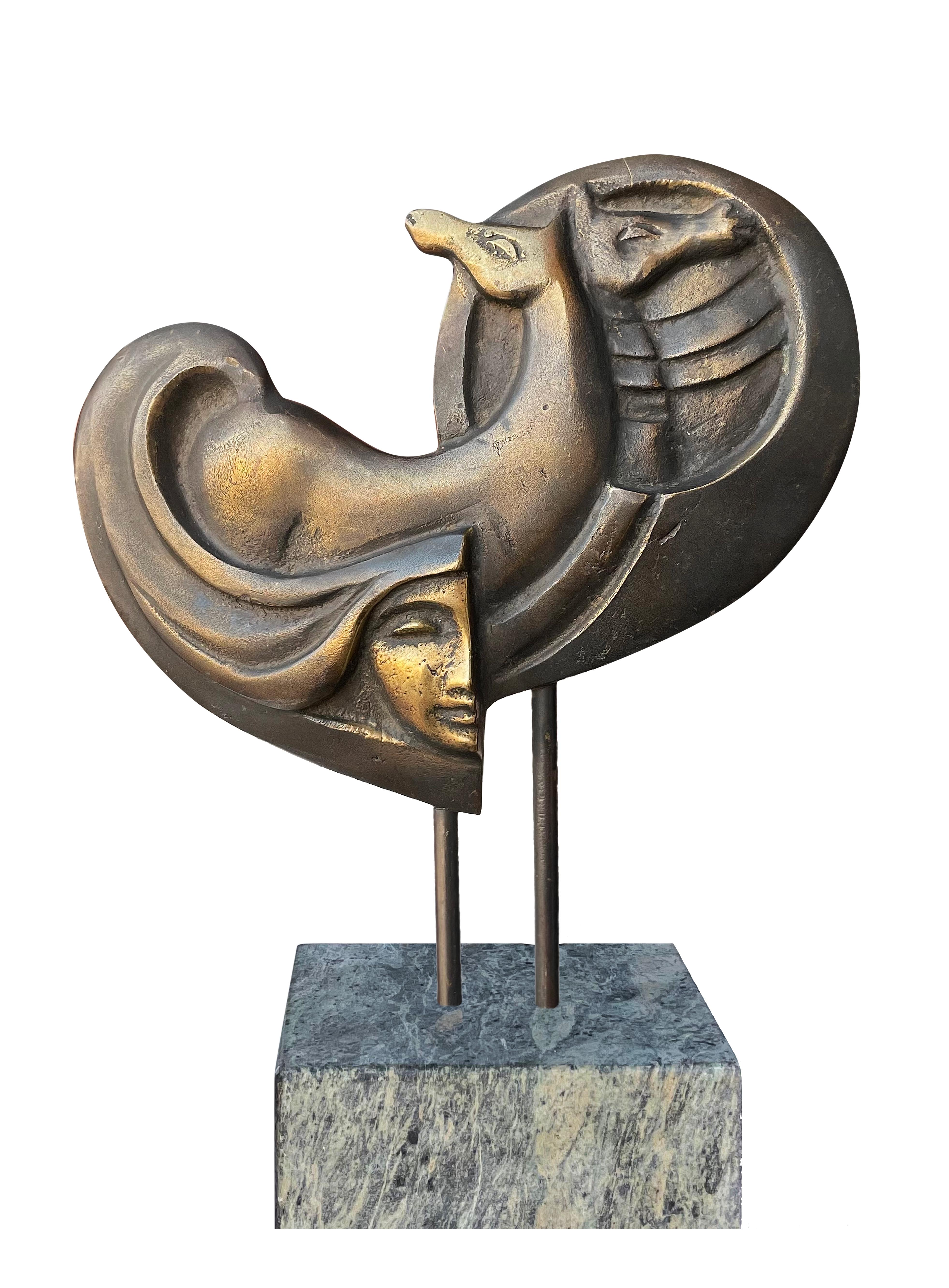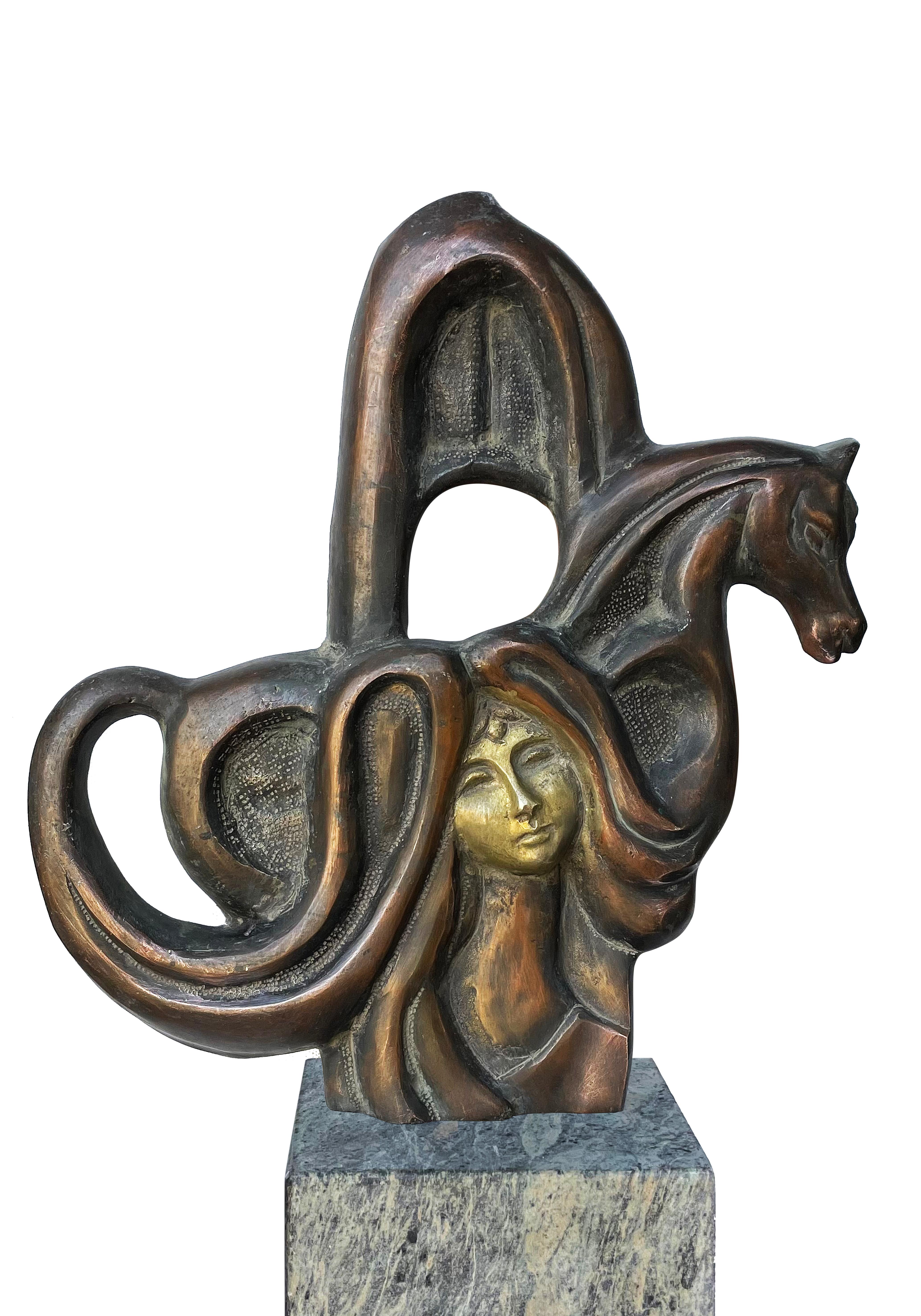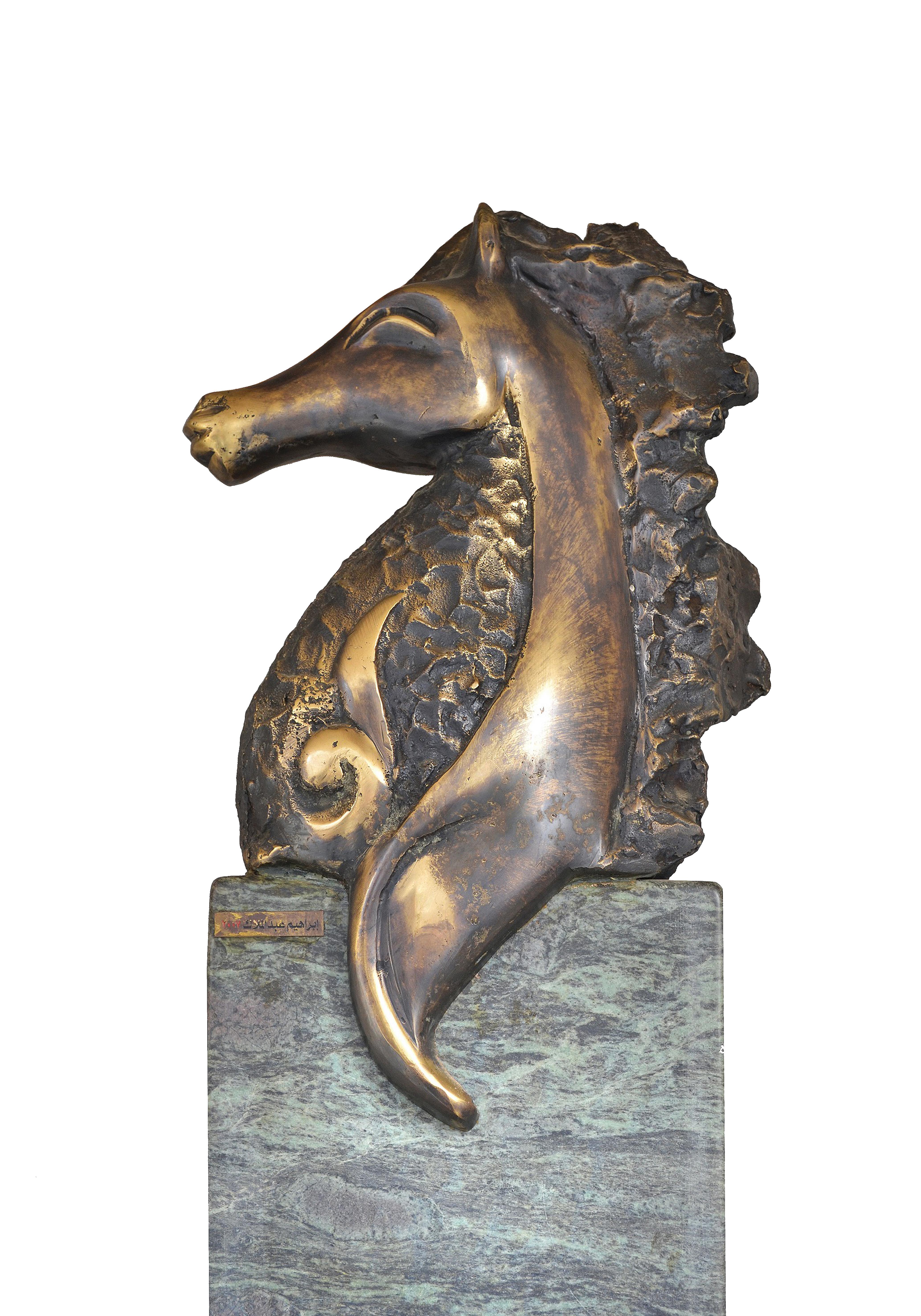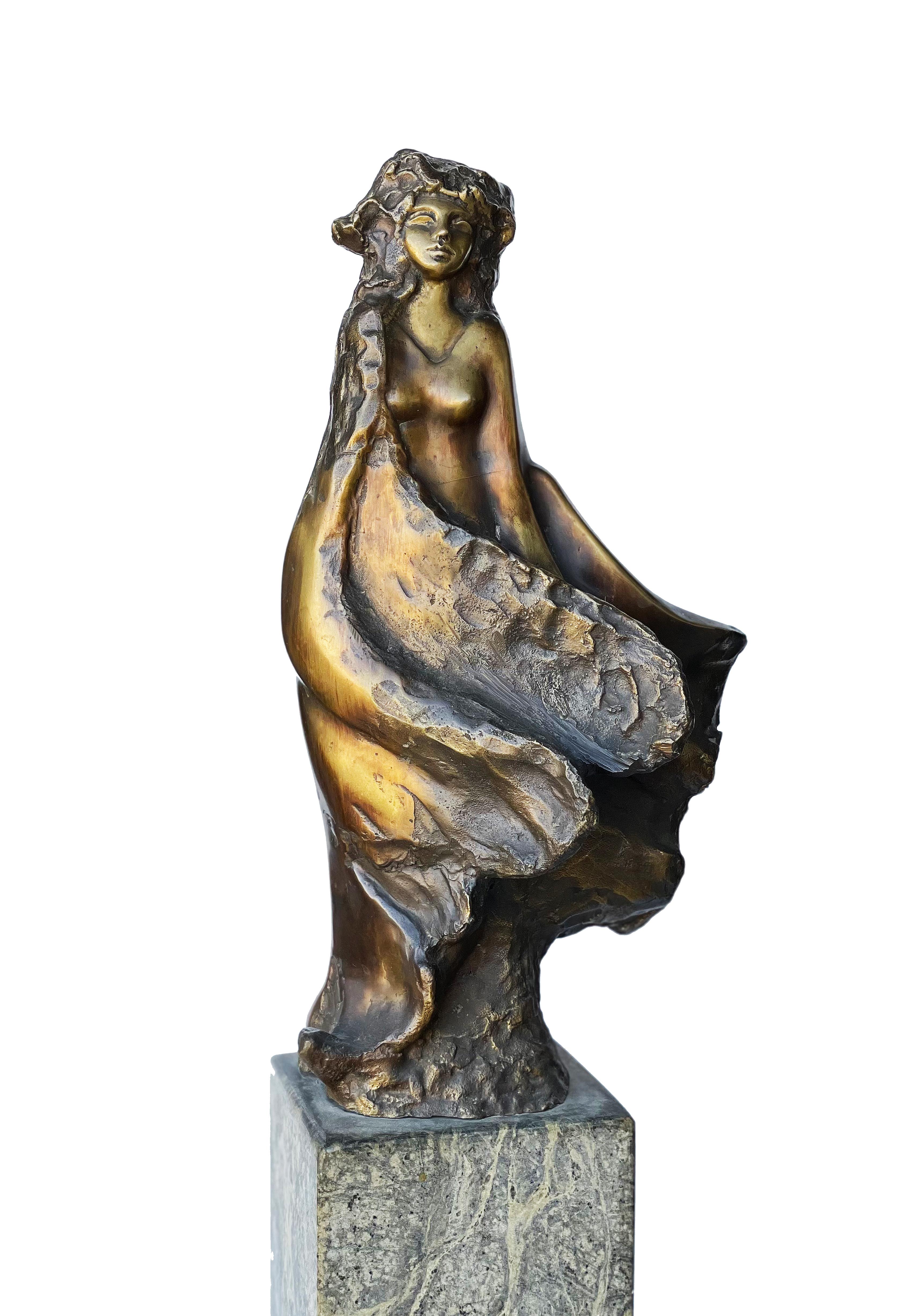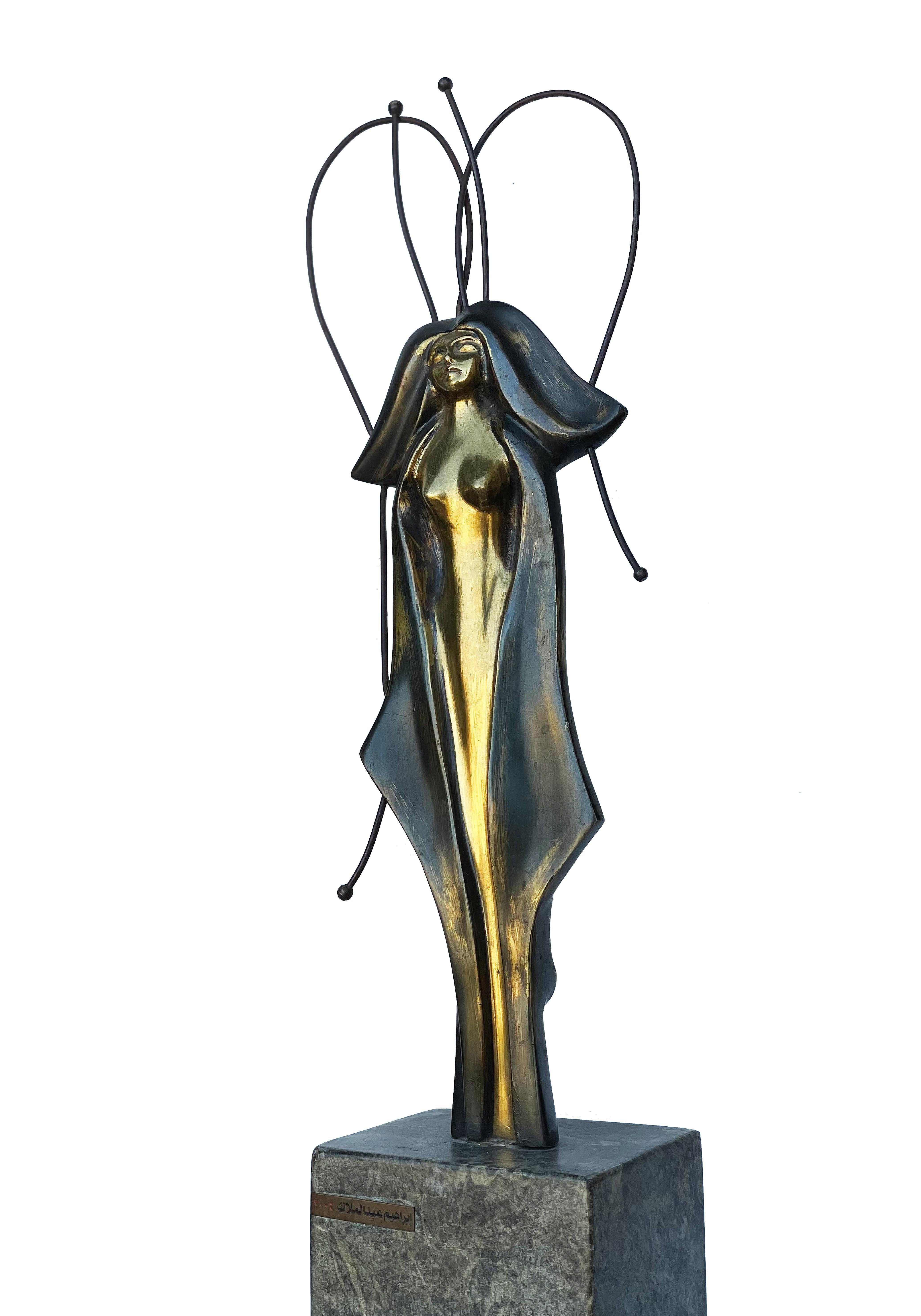Items Similar to Bronze Sculpture Abstract Brutalist Goat or Ram WPA Artist Mounted on Base
Want more images or videos?
Request additional images or videos from the seller
1 of 8
Benedict Michael TattiBronze Sculpture Abstract Brutalist Goat or Ram WPA Artist Mounted on Basec.1950's
c.1950's
About the Item
Benedict Tatti (1917-1993) worked in New York city as a sculptor, painter, educator, and video artist. He studied stone and wood carving under Louis Slobodkin at the Roerich Museum. He later attended the Leonardo da Vinci School of Art studying under Attilio Piccirelli. In l939 he taught adult classes with the Teachers Project of the WPA and attended the Art Students League for three and a half years on full scholarship. He studied under William Zorach and Ossip Zadkine and later became Zorach’s assistant. Later in his career, he attended the Hans Hofmann School of Fine Arts. During World War II, Tatti served in the United States Army Air Force, where he spent three years assigned to variety of projects. In 1948, Benedict Tatti married Adele Rosenberg in New York City.
Throughout his career, Tatti continuously experimented with various media. From 1952-1963, Tatti executed sculptural models of architectural and consumer products for the industrial designers, Raymond Loewy Associates; later he became a color consultant for the firm. In the 1960s, influenced by the Abstract Expressionists, Tatti turned from carving directly in wood and stone to creating assemblage architecture sculptures, using bronze metal and other industrial materials.
He was included in the important show "Aspects de la Sculpture Americaine", at Galerie Claude Bernard Paris, France, in October 1960 along with Ibram Lassaw, Theodore Roszak, David Smith, Louise Bourgeois, Danese Corey, Dorothy Dehner, Lin Emery, Lily Ente, David Hayes, Louise Nevelson, Tony Rosenthal, Richard Stankiewicz, Sam Szafran and Benedict Tatti. During this period, Tatti spent summers on Monhegan Island in Maine, where he developed his watercolor techniques. In the 1970s, Tatti, with no previous background in video work developed technology for video imaging. He became an associate member of the Kitchen at the Mercer Arts Center exhibiting his video sculptures along with other early innovators of this new art form. He assisted his brother, Alexander Tatti and his nephew, Steven Tatti on the restoration of the Statue of Liberty on Ellis Island. Benedict Tatti received solo and group exhibitions at museums and galleries in the United States and abroad, including the Burr Gallery, Claude Bernard Galleries, ACA Gallery, Puma Gallery, Weyhe Gallery and Metropolitan Museum of Art, under the Artists for Victory Program, Museum of Modern Art, National Gallery of Art, Northeast Gallery, Pennsylvania Academy of the Fine Arts, and the Roko Gallery. Also, Tatti's work was regularly featured in annual exhibitions of several arts organizations: American Society of Contemporary Artists, Annual Avant Garde Festival, Audubon Artists, Brooklyn Society of Artists, and Painters and Sculptors Society of New Jersey. His awards included the National Soldier Art Competition at the National Gallery of Art (1945); Artist-in-Residence, National Center of Experiments TV, San Francisco, California, (1969); and the Creative Artists Public Service (CAPS), (1972). Tatti's artwork is in the permanent collections of the American Numismatic Society, Art Students League, Dumbarton Oaks, Monhegan Museum, Smithsonian Institution, and the Usdan Center for the Creative and Performing Arts.
He won first prize for his sculpture, “Soldier”, in the National Soldier Art Competition, which was exhibited at the National Gallery of Art, Washington, D. C. and the Chicago Art Institute. He continued to direct carve both wood and stone into the decade of the fifties. He also developed his watercolor techniques during summer visits to Monhegan Island, Maine, where many of his friends summered.
- Creator:Benedict Michael Tatti (1917 - 1993, American)
- Creation Year:c.1950's
- Dimensions:Height: 13 in (33.02 cm)Width: 15 in (38.1 cm)Depth: 6 in (15.24 cm)
- Medium:
- Movement & Style:
- Period:
- Condition:good. base has minor wear.
- Gallery Location:Surfside, FL
- Reference Number:1stDibs: LU3826305452
About the Seller
4.9
Platinum Seller
These expertly vetted sellers are 1stDibs' most experienced sellers and are rated highest by our customers.
Established in 1995
1stDibs seller since 2014
1,560 sales on 1stDibs
Typical response time: 1 hour
- ShippingRetrieving quote...Ships From: Surfside, FL
- Return PolicyA return for this item may be initiated within 3 days of delivery.
More From This SellerView All
- Karel Appel Colorful Expressionist Hand Painted Wood Cobra Sculpture Pop ArtBy Karel AppelLocated in Surfside, FLThis is an original wooden sculpture with hand painting on both sides. it does not appear to be signed or numbered and does not currently have any label. I believe this might be the proof, There was an edition of these and this is a unique variant. All done by hand. It is on a base and revolves and rotates easily as there are ball bearings. It is very well made. Christiaan Karel Appel (1921-2006) was a Dutch artist, painter, sculptor, and poet. Born in Amsterdam, the Netherlands, he died in Zurich, Switzerland. He started painting at the age of fourteen and studied at the Rijksakademie in Amsterdam in the 1940s. He was one of the founders of the avant-garde movement Cobra in 1948. He was also an avid sculptor and has had works featured in MoMA, the Stedelijk and other museums worldwide. At fourteen, Appel produced his first real painting on canvas, a still life of a fruit basket. For his fifteenth birthday, his wealthy uncle Karel Chevalier gave him a paint set and an easel. An avid amateur painter himself, Chevalier gave his namesake some lessons in painting. From 1940 to 1943, during the German occupation, Appel studied at the Rijksakademie van Beeldende Kunsten in Amsterdam, and it was there he met the young painter Guillaume Corneille and, some years later, Constant; they became close friends for years. Appel had his first show in Groningen in 1946. In 1949 he participated with the other CoBrA artists in the Stedelijk Museum Amsterdam; this generated a huge scandal and many objections in the press and public. He was influenced by Pablo Picasso, Henri Matisse, and the French brute-art artist Jean Dubuffet. In 1947 he started sculpting with all kinds of used materials (in the technique of assemblage) and painted them in bright colors: white, red, yellow, blue, and black. He joined the Experimentele Groep in Holland together with the young Dutch painters Anton Rooskens...Category
1970s Abstract Expressionist Abstract Sculptures
MaterialsWood, Paint
- French Pop Art Heavy Bronze Sculpture Chess Game Gambit Arman AccumulationBy ArmanLocated in Surfside, FLArman, French American (1928-2005) Gambit (Chess pieces) Cast Bronze Sculpture with patina Incised signature near lower edge, 48/70 with impressed "Bronze Romain & Fils" foundry ma...Category
Early 2000s Abstract Figurative Sculptures
MaterialsBronze
- Large Bronze Modernist Biomorphic Sculpture Sleeping Dog Colin Webster WatsonLocated in Surfside, FLSculpture Of A Sleeping Dog. A wonderful and realistic cast bronze signed and numbered. With beautiful weathered patina Small edition of 10 Colin Webs...Category
1970s Abstract Sculptures
MaterialsBronze
- Mexican Art Abstract Brutalist Biomorphic Bronze Sculpture Mathias GoeritzBy Mathias GoeritzLocated in Surfside, FLMathias Goeritz (German Mexican, 1915-1990) Bronze sculpture Signed and numbered Dimensions: (approximate) Height: 10 inches, Width: 4 inches, Depth: 2 inches. This is a cast bronze sculpture in an amorphous figure shape, quite heavy. Reminiscent of the biomorphic sculpture of Hans Jean Arp. This came from an estate and bears his signature It is not dated. there is no accompanying documentation. it is priced accordingly. Werner Mathias Goeritz Brunner (Danzig, Germany, April 4th, 1915/ now Gdansk, Poland – Mexico City, Mexico; August 4th, 1990). Mathias Goeritz has had several gallery and museum exhibitions, including at the Museo Nacional Centro de Arte Reina Sofía and at the Museo Experimental El Eco. Numerous works by the artist have been sold at auction, including 'MENSAJE' sold at Sotheby's New York 'Latin American Modern Art' in 2015 for $466,000. There have been Several articles about Mathias Goeritz, including 'LACMA remaps Latin America' written by Suzanne Muchnic for the Los Angeles Times. Painter, sculptor and Mexican architect associated with the trend of constructive abstraction. He studied medicine at the University of Berlin, but this only lasted a year. The concerns of the young student were aesthetic in nature so he he studied figurative drawing at the Berlin Charlottenburg School of Art. Some of his friends and colleagues were the sculptor Ernst Barlach, painter George Grosz and draughtsman Kaethe Kollwitz. Goeritz studied philosophy and history of art, discipline in which earned a doctorate. He travelled in France, Switzerland, Czechoslovakia, Poland, Austria and Italy, among other countries. It is known that he left Germany to live in Tetuan, Morocco in 1941 and then Granada, Spain in 1945. In 1946 he had a large exhibition in the Sala Clan in Madrid under the pseudonym "Mago". Two years later, living in Santilla del Mar, Spain he was a founder of the Escuela de Altamira. The following year he married Marianne Gast, writer and his companion for more than fifteen years. In Spain followed his artistic work by important artists of the avant-garde. Of Jewish descent, he found refuge from the Second World War in Mexico where in 1949 he was invited by Ignacio Diaz Morales to be a part of the faculty of the School of Architecture at the Universidad de Jalisco. In 1953 he wrote the "Manifiesto de la Arquitectura Emocional" (The Emotional Architecture Manifesto), where he points out that only achieving true emotions from architecture can it then be considered an art form. In Mexico he entered controversy with the artistic stablishment of that country; in an open letter, Diego Rivera and David Alfaro Siqueiros described him as "an impostor without the most insignificant talent and preparation" to be an artist. Despite this, in 1957 he was elected director of visual design of the National School of architecture This same year he founded the Museo del Eco in Mexico City. In 1961 Goeritz participated at the Galería Antonio Souza in a group exhibition, Los hartos, for which he published another manifesto. Other participants included Jose Luis Cuevas and Pedro Friedeberg, with whom he was instrumental in establishing abstraction and other modern trends in Mexico.His work is included in the Gelman Collection of modern and contemporary Mexican art based in Cuernavaca, Mexico. Established by Jacques and Natasha Gelman in 1943 as a private collection. it includes many iconic works by major Mexican Modernists including Frida Kahlo, Diego Rivera, David Alfaro Siqueiros, Leonora Carrington, Rufino Tamayo and Francisco Toledo, Lola Alvarez...Category
20th Century Modern Abstract Sculptures
MaterialsBronze
- Brutalist Modern Abstract Bronze Sculpture Metropolis Manner of Louise NevelsonBy Abbott PattisonLocated in Surfside, FLA very heavy, massive bronze sculpture by an important Chicago sculptor. Signed and marked "Firenze" with "Fuse Marinelli". METROPOLIS. Seven abstract shapes on black marble base. 1...Category
20th Century Modern Abstract Sculptures
MaterialsMarble, Bronze
- Bronze Architectural Model Sculpture Tempio Bretton Architecture MaquetteLocated in Surfside, FLTEMPIO BRETTON: from the catalogue MONUMENTA, 19th International Sculpture Biennale, Antwerp, Belgium. Tempio Bretton was created in homage to the celebrated English landscapist Capability Brown for the occasion of an exhibition at Bretton Hall in the Yorkshire Sculpture Park , a park in the style of the great master of English garden design. The inclusion in the English garden of a temple ruin, or "eye-catcher," (architectural folly) was used to draw the eye and mind to a focus in time and space, present the beholder with an immediate relationship to an historic past made new within his or her own surroundings, and create a depth of space never before seen in garden design. I took the idea of the temple ruin eye-catcher and reduced it to a scale at the point where architecture and sculpture merged. Tempio Bretton is not capacious enough to walk into, yet it is considerably larger than a man. One view of it presents a knot of golden columns clustered together, topped by a dome shape. The only clue from this side to the temple's non-conformity to historic principle is a sharp notch cut into the square base. Viewed from the opposite side, the cluster of columns capped by an angular top opens up as if to welcome someone in, yet the mysterious core is still impenetrable. These contradictions articulate a confrontation between past and present, and an exciting truth. The past is always at the heart of our constructions in the present. Walter Dusenbery...Category
20th Century American Modern Abstract Sculptures
MaterialsBronze
You May Also Like
- "Love of Horses" Bronze and Marble sculpture 16" x 7" in by Ibrahim Abd ElmalakLocated in Culver City, CA"Love of Horses" Bronze and Marble sculpture 16" x 7" in by Ibrahim Abd Elmalak Love of Horses, 2000 Bronze & Marble (Double Face) 40 x 18 cm, Signed & Dated Sculptures that mostl...Category
21st Century and Contemporary Abstract Expressionist Figurative Sculptures
MaterialsMarble, Bronze
- "Entropy" Bronze sculpture 22" x 9" inch by Ibrahim Abd ElmalakLocated in Culver City, CA"Entropy" Bronze sculpture 22" x 9" inch by Ibrahim Abd Elmalak Entropy, 2005 Bronze & Marble Signed & Dated Sculptures that mostly depict his ...Category
21st Century and Contemporary Abstract Expressionist Figurative Sculptures
MaterialsMarble, Bronze
- "Equine Spirit II" Bronze sculpture 23" x 14.5" inch by Ibrahim Abd ElmalakLocated in Culver City, CA"Equine Spirit II" Bronze sculpture 23" x 14.5" inch by Ibrahim Abd Elmalak Equine Spirit II, 1997 Bronze & Marble Signed & Dated Sculptures that mostly depict his characteristic...Category
20th Century Abstract Expressionist Figurative Sculptures
MaterialsMarble, Bronze
- "Grecian Stallion I" Bronze sculpture 24" x 11" inch by Ibrahim Abd ElmalakLocated in Culver City, CA"Grecian Stallion I" Bronze sculpture 24" x 11" inch by Ibrahim Abd Elmalak Grecian Stallion I, 2007 Bronze & Marble Signed & Dated Sculptures that mostly depict his characterist...Category
21st Century and Contemporary Abstract Expressionist Figurative Sculptures
MaterialsMarble, Bronze
- "Gloria" Bronze and Marble sculpture 27" x 11" in by Ibrahim Abd ElmalakLocated in Culver City, CA"Gloria" Bronze and Marble sculpture 27" x 11" in by Ibrahim Abd Elmalak Gloria, 2007 Bronze & Marble 68 x 27 cm, Signed & Dated Sculptures that mostly depict his characteristic ...Category
21st Century and Contemporary Abstract Expressionist Figurative Sculptures
MaterialsMarble, Bronze
- "Equine Spirit I" Bronze sculpture 14.5" x 6" inch by Ibrahim Abd ElmalakLocated in Culver City, CA"Equine Spirit I" Bronze sculpture 14.5" x 6" inch by Ibrahim Abd Elmalak Double-faced Bronze & Marble Signed & Dated Sculptures that mostly depict his characteristic figures of...Category
20th Century Abstract Expressionist Figurative Sculptures
MaterialsMarble, Bronze
Recently Viewed
View AllMore Ways To Browse
Bronze Base Sculpture
Brutalist Base
S Ellis
Kitchen Sculptures
Abstract Bronze Modern Sculpture
Carved Wood Sculpture Abstract
Wood Midcentury Sculpture Abstract
Modern Stone Sculpture On Base
Abstract Bronze Sculpture On Base
Ellis Island Vintage
Wood Brutalist Sculpture
Carved Artist Model
Brutalist Wood Art
Mid Century Abstract Bronze Sculpture
Mid Century Bronze Abstract Sculpture
Brutalist Bronze Sculpture
Rams In Art
Industrial Bronze Sculpture
